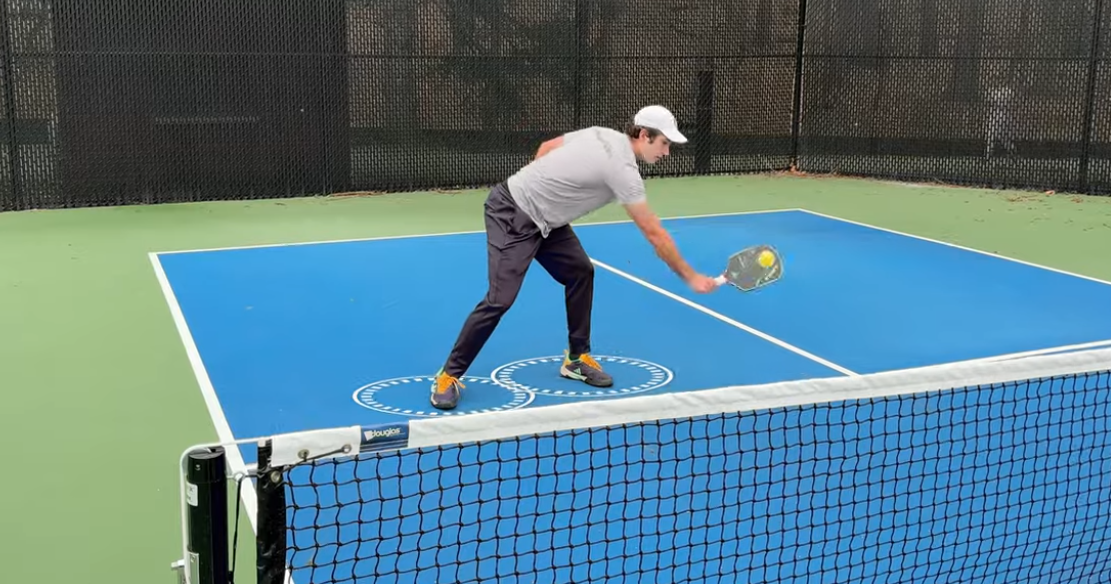Using Advanced Techniques and AI-Driven Insights
Why Footwork is the Secret to Pickleball Mastery
I remember the first time I stepped onto a pickleball court. My feet felt like lead weights, and I couldn’t react fast enough to get into position. I was frustrated, but I quickly realized that the secret to success in pickleball isn’t just in your paddle skills—it’s in your footwork.
Great pickleball players don’t just react to shots; they anticipate and move efficiently before the ball even arrives. Mastering footwork allows you to move with purpose, conserve energy, and maintain control over every shot.
But here’s where most players miss a game-changing opportunity…
What if you could take your footwork beyond traditional drills? What if you could train like a pro using AI-driven predictive models, cognitive conditioning, and biomechanics principles?
In this guide, we’re going far beyond basic shuffles and split-steps. You’ll learn how to supercharge your footwork using game theory, neural conditioning, and cutting-edge technology—all while preventing injuries and maintaining balance as you age.
Understanding Pickleball Movement: The Science Behind It
Pickleball movement isn’t just about speed—it’s about precision. Footwork in pickleball involves:
✅ Explosive Lateral Movement: Quick side-to-side shuffles to cover the court effectively.
✅ Agility and Directional Control: Pivoting and split-stepping to react instantly to incoming shots.
✅ Balance and Stability: Staying low and balanced, ensuring quick recovery after each shot.
But here’s where most players go wrong…
They underestimate how critical core engagement and optimal weight distribution are for reducing fatigue and boosting reaction time. Studies on racket sports, including pickleball, show that correct posture reduces muscle fatigue and enhances longevity on the court.
The Split-Step: Your Launch Pad for Better Footwork
The split-step is a universal move in racket sports, and in pickleball, it’s your best friend.
How to Execute a Perfect Split-Step:
- Stand in the ready position with your knees slightly bent and weight on the balls of your feet.
- As your opponent makes contact with the ball, perform a small hop.
- Land on the balls of your feet, primed to explode in any direction.
- Push off immediately toward the ball, maintaining balance and control.
Pro Tip: Use slow-motion video analysis (via AI apps like Dartfish or Hudl) to identify micro-delays in your split-step and fine-tune your reaction time.
AI-Powered Predictive Footwork: Anticipate Before You React
Want to know the #1 mistake even experienced players make?
They react too late. What if you could predict where your opponent will hit the ball before they even make contact?
AI-powered predictive models can simulate real-world scenarios, analyzing shot patterns from elite players and recommending the best footwork response.
AI Simulation Training:
- Pattern Recognition Algorithms: Learn shot patterns and calculate optimal positioning.
- Smart Sensors & Wearables: Devices like smart insoles provide real-time data on foot pressure and lateral stability.
- Heatmap Visualization: AI-generated footwork heatmaps reveal high-probability zones where the ball is likely to land.
Drill Idea:
Record a series of practice games, upload them to an AI-driven analysis platform, and analyze recurring shot patterns. Adjust your footwork in response to predicted ball trajectories.
👉 Further Reading: Check out the Topspin Pro Review to enhance your ability to predict shot spins and trajectories.
Cognitive Conditioning: Training Your Brain for Faster Reactions
Ever wondered why pros seem to be in the right place every time?
Elite athletes combine physical speed with mental agility. Integrating cognitive conditioning into your training enhances anticipatory footwork and reduces decision-making delays.
Dual-Task Drills to Enhance Cognitive-Footwork Synergy:
- Reaction Light Drills: Use light-based cues to practice moving to different zones, training your sensorimotor cortex for rapid responses.
- Audio Cue Drills: Respond to auditory commands while performing footwork patterns, strengthening neural pathways for split-second reactions.
- Pattern Recognition Games: Mentally predict shot placement based on your opponent’s paddle angle and body positioning.
Pro Tip: Incorporate visual motor rehearsal—visualize different shot outcomes and mentally rehearse your footwork response before matches. Studies show that athletes who practice mental rehearsal can improve physical response time by up to 20%.
👉 Related Insight: Explore how grip techniques impact performance to take cognitive conditioning to the next level.
Lateral Movement: The Pickleball Shuffle 2.0
In pickleball, lateral movement is key. But the standard shuffle can be upgraded by integrating micro-mobility drills that focus on rapid direction changes while maintaining balance.
The Evolution of the Shuffle:
- Baseline Shuffle with Pause Technique: Pause briefly between steps to ensure balance before exploding into the next position.
- Pivot-Push Shuffle: Use a quick pivot on your outside foot to create a smoother transition between lateral movements.
- Reactive Shuffle Matrix: Randomize direction changes mid-shuffle using audio or visual cues to simulate game unpredictability.
Drill Idea:
Set up cones 3-5 feet apart and practice shuffle-pivot-shuffle sequences. Use a reaction timer to measure response time between movements.
Game Theory and Decision-Tree Footwork Strategy
Footwork isn’t just about physical movement—it’s about positioning yourself where the ball will be. What separates average players from those who dominate the court?
How to Apply Game Theory to Footwork:
- Nash Equilibrium Footwork: Position yourself in a neutral stance that covers the highest percentage of probable shots.
- Decision-Tree Anticipation Models: Develop instinctive responses to different opponent styles by predicting their preferred shot trajectories.
- Risk-Reward Footwork Matrix: Identify situations where an aggressive step toward the net outweighs the risk of being out of position.
Pro Tip: Create a footwork decision matrix that outlines optimal court positioning based on shot probability and opponent tendencies.
👉 Enhance Your Strategy: Learn how to choose the perfect pickleball paddle to complement your strategic footwork.
Footwork for Longevity: Injury Prevention and Adaptation
As players age, maintaining footwork efficiency becomes critical for injury prevention and longevity.
Joint-Friendly Footwork Modifications:
- Low-Impact Shuffle Techniques: Shorten step length while maintaining quick lateral movement to reduce knee stress.
- Proprioceptive Stability Drills: Enhance balance and core control through exercises that target small stabilizing muscles.
Pro Tip: Incorporate yoga and plyometric drills into your routine to build balance, mobility, and strength.
👉 Stay Game-Ready: Check out what to wear for pickleball to stay comfortable and reduce injury risk.
Key Takeaways: The Road to Footwork Mastery
To elevate your pickleball footwork to professional levels:
✅ Master the split-step for explosive starts.
✅ Use AI-driven pattern recognition to anticipate shots before they happen.
✅ Train your brain with cognitive conditioning for split-second decisions.
✅ Apply game theory decision trees to position yourself optimally on the court.
✅ Develop adaptive footwork strategies that neutralize different opponent styles.
Every great pickleball player started with basic footwork. But by embracing advanced techniques, cognitive conditioning, and AI-driven insights, you can go beyond reaction—and become the kind of player who controls the game.

